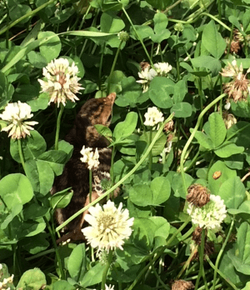All of the above mentioned is very good talk. The more land you own, the better of course. And I realize and understand everyone cannot do it. I only have about 70 acres. Not a lot, but I want to get a hen or two to attempt a nest on it and hopefully raise a brood.
First of all, there's got to be turkeys around to make more turkeys, that's one thing that hurts me, is that this season the area was void and I don't know why. Most spring and summers we will have two to three long beards in and out and a handful of hens hanging around. This is the first year since 2015 I haven't had a poult yet on camera, still early but I doubt I get one because I've only seen a couple of hens. But maybe we will. My place doesn't have birds on it until late March, and they stay until August/September. Then they flock up, and migrate to who knows where, I'd say around 10-15 miles north. Then as mid March comes back, birds disperse, and we get them again.
I try to let my grass and weeds grow up, and I try to eradicate all fescue. My fields look like junk, lots of weeds and sage grass. I border my tall grass fields with food plots of clovers mixed with wheat or rye. I will occasionally disk around the edges of food plots, and some years I disk down the middle. A good 5-8 foot wide disked area. I will mow my plots after I think the hatching season is over, but not all at once and not real short. Just knock the tops off. Every two years or so I will bush hog low a section of field, and usually just disk it in and maybe plant it with a cool season annual like wheat/crimson clover. Let it grow back again and repeat cycle.
Common sense says the egg is the most vulnerable part of their lives, and it may be but in my experience it seems like once they hatch within the first week about all of them are gone. One hard rain and it may get 9 of 12. But that is the part we cannot control. Trapping is great, but I think it's overrated. If you have the right habitat, you will or should attract enough hens to counter the nest thieves. Also, about season timing and structure, those hens will usually attempt a second and sometimes a third clutch.
Next, if you have the right vegetation for the poults to feed in you will find success. They have to be able to catch grass hoppers, but also have enough cover to hide from hawks over head. Cannot be too tall for the hen to see out of though. She sees a hawk, the poults can scatter or freeze. If it's fescue, they can't run through it quick enough and get caught. Same with a quail.
God designed bobcats and foxes to prey on poults and quail, but he also designed poults and quail to be able to escape. The man made introduction of fescue and other thick turf grasses for grazing and hay have destroyed a lot of turkey and quail habitat. If you have a good mix of native warm season grasses (broom sedge is easiest for me to grow) along with a few herbaceous or broadleaf weeds you will be able to provide cover from avian predators as well as running areas underneath so that they can flee from bobcats and foxes.
If you can get them to about 12-14 days old, your in good shape because then they can fly and roost in trees at night. (I think 14 days is flying age, I have forgotten.)
Next, the weather needs to be on your side. The older they get the more cold tolerant they get. But I believe at about 7 weeks is when they have gotten rid of all downy feathers and are full plumaged, and are able to create their own body heat. (May have my age wrong here too, but it's in that neighborhood.)
So once poults make it to August and September, man is about the only thing that gets them.
Predator control is important. But it's not even in the same stratosphere of importance as habitat. The most important predators to target will be your raccoons, skunks, possums, and I assume armadillos. they are nest raiders and actively search for nest. Your bobcats and coyotes are opportunistic, and will try and catch poults or adults, and will catch some, but I do not believe that these larger predators are very destructive on the turkey population. Think about it. A coyote will go and catch one turkey. A raccoon will find a nest and catch 13 turkey eggs. I have also seen two times, one of each, a bobcat or coyote near turkeys. In the coyote case, the gobbler didn't even stop strutting and the hens just stood erect watching real close. When the bobcat came near, I didn't see the bobcat until after the turkeys did. The turkeys all stretched up and started clicking or putting real loud, and eventually I saw a bobcat easing through the woods.
I suggest anyone looking into improve their habitat to look into NRCS programs, get some good turkey biology reads, and also I highly recommend reading the "My Life as a Turkey" journal.
Sent from my iPhone using Tapatalk

